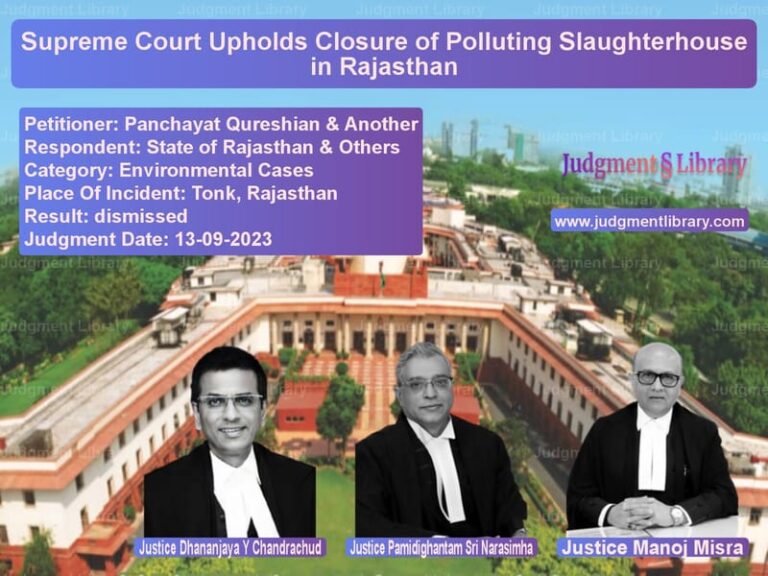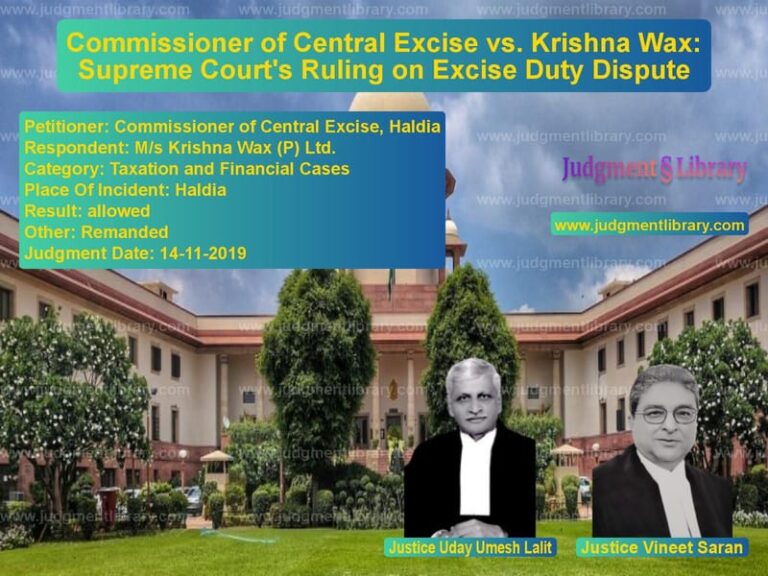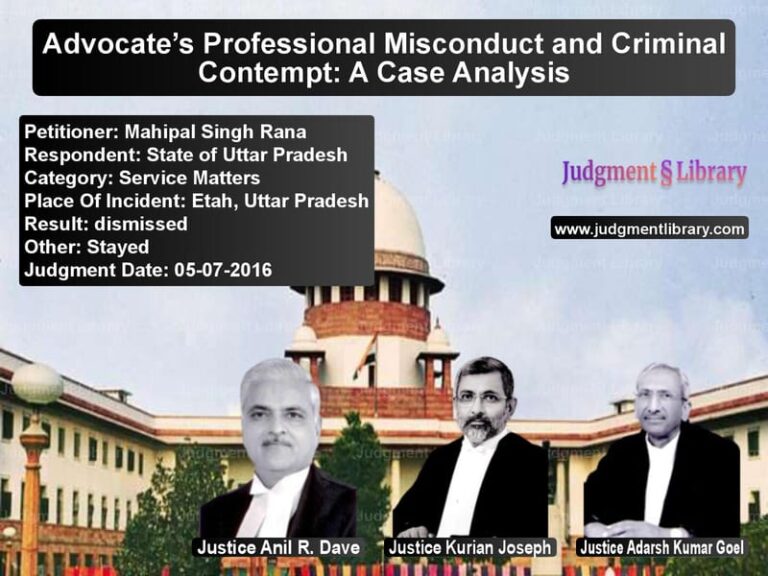Eyewitness Credibility in Criminal Trials: Supreme Court Acquits Murder Accused
The case of State of Uttar Pradesh v. Om Pal & Ors. revolves around the murder of Mahipal, where the prosecution relied heavily on eyewitness testimony to convict the accused. However, discrepancies in the statements of key witnesses led the Supreme Court to uphold the High Court’s decision to acquit the accused, emphasizing the importance of credibility and consistency in witness testimonies.
This case highlights crucial aspects of criminal law, particularly how courts evaluate evidence and apply the principle of ‘beyond reasonable doubt’ before convicting individuals. The Supreme Court’s decision serves as a reminder that mere allegations or inconsistencies in witness statements can lead to acquittals, even in serious criminal cases like murder.
Background of the Case
According to the prosecution, on March 25, 1993, at approximately 9:00 a.m., Mahipal and his wife, Prakashee, were traveling on a buffalo cart to their fields when three accused—Om Pal, Mukhtiar, and Navin—emerged from a sugarcane field and attacked Mahipal. It was alleged that:
- Om Pal fired at Mahipal but missed.
- Mukhtiar fired at Mahipal, hitting him.
- Navin assaulted Mahipal with the butt of a firearm.
Dharmendra (PW2), an alleged eyewitness, informed Naresh Pal (PW1), Mahipal’s relative, who then filed the First Information Report (FIR). Mahipal succumbed to his injuries while being taken to the hospital.
Arguments by the Prosecution
The State of Uttar Pradesh presented the following arguments:
- The prosecution relied on three key witnesses—Naresh Pal (PW1), Dharmendra (PW2), and Prakashee (PW3), Mahipal’s wife—who allegedly saw the crime.
- The accused had a motive for murder, as Mahipal was involved in an earlier criminal case where one of the accused had been shot.
- The medical evidence supported the prosecution’s case and matched the injuries sustained by Mahipal.
- The recovery of illegal firearms from the accused further corroborated their involvement.
Arguments by the Defense
The defense countered the prosecution’s claims, arguing that:
- The eyewitness testimonies were inconsistent and unreliable.
- There was a history of enmity between Mahipal and the accused, which could have led to false implication.
- The prosecution failed to present independent witnesses, relying solely on interested parties.
- Despite being present, the eyewitnesses did not immediately report the crime to the police.
Trial Court’s Decision
The Trial Court convicted the accused under Section 302 read with Section 34 of the Indian Penal Code (IPC), sentencing them to life imprisonment and a fine of Rs. 5,000 each. The court relied heavily on the testimonies of PWs 1, 2, and 3, considering them sufficient to establish the accused’s guilt.
High Court’s Decision
The High Court overturned the trial court’s verdict, finding several flaws in the prosecution’s case:
- Unreliable Eyewitnesses: The testimonies of PW2 (Dharmendra) and PW3 (Prakashee) contained contradictions and did not inspire confidence.
- Delayed Statements: Prakashee’s statement was recorded a month after the incident, allegedly due to her shock, but there was no medical proof to support this claim.
- Lack of Independent Witnesses: Despite the crime occurring in a public area, no neutral witnesses corroborated the prosecution’s claims.
- Contradictions in Evidence: PW1 (Naresh Pal) had contradictory statements regarding how he learned of the incident.
Supreme Court’s Analysis
The Supreme Court reaffirmed the High Court’s findings and emphasized key legal principles in criminal trials:
1. Reliability of Witness Testimonies
The Court scrutinized the statements of PWs 1, 2, and 3, noting serious inconsistencies:
- PW1 was not present at the crime scene but filed the FIR based on hearsay from PW2.
- PW2 changed his version multiple times and failed to explain his presence at the crime scene convincingly.
- PW3’s delay in recording her statement raised doubts about its credibility.
“The conduct of PW2 (Dharmendra) and PW3 (Prakashee) does not inspire confidence. The inconsistencies in their statements weaken the prosecution’s case.”
2. Presumption of Innocence and Benefit of Doubt
The Supreme Court reiterated that an accused is presumed innocent until proven guilty beyond reasonable doubt:
“The prosecution must establish its case with cogent evidence. Mere suspicion, however strong, cannot take the place of proof.”
3. Importance of Independent Witnesses
The Court observed that the prosecution failed to produce independent witnesses, despite the crime occurring in a populated area:
“The absence of independent witnesses raises serious doubts about the truthfulness of the prosecution’s version.”
4. Role of Motive in Criminal Trials
While the prosecution argued that enmity provided a motive, the Court held that motive alone cannot substitute for substantive evidence:
“While motive is relevant, it cannot be the sole basis of conviction in the absence of credible evidence.”
Supreme Court’s Final Verdict
The Supreme Court upheld the High Court’s acquittal, ruling:
“The prosecution has failed to prove the case beyond reasonable doubt. The High Court committed no illegality in acquitting the accused.”
The Court dismissed the appeal, affirming that the accused should be given the benefit of doubt.
Key Takeaways
- Eyewitness testimonies must be consistent and credible to sustain a conviction.
- Independent witnesses play a crucial role in corroborating the prosecution’s case.
- The benefit of doubt must always go to the accused in cases of conflicting evidence.
- Motive alone is not enough to convict an accused without substantive proof.
- Courts must ensure that justice is served based on reliable and admissible evidence.
Conclusion
The Supreme Court’s judgment in this case underscores the principle that in criminal trials, evidence must be evaluated meticulously to ensure justice. The Court’s decision highlights the necessity for eyewitnesses to be credible and consistent and reinforces that mere suspicion or enmity cannot replace concrete proof.
By acquitting the accused, the Court reaffirmed the importance of due process and the fundamental principle that every individual is innocent until proven guilty beyond reasonable doubt.
Petitioner Name: State of Uttar PradeshRespondent Name: Om Pal & Ors.Judgment By: Justice N.V. Ramana, Justice S. Abdul NazeerPlace Of Incident: Ghaziabad, Uttar PradeshJudgment Date: 21-03-2018
Don’t miss out on the full details! Download the complete judgment in PDF format below and gain valuable insights instantly!
Download Judgment: State of Uttar Prade vs Om Pal & Ors. Supreme Court of India Judgment Dated 21-03-2018.pdf
Direct Downlaod Judgment: Direct downlaod this Judgment
See all petitions in Murder Cases
See all petitions in Attempt to Murder Cases
See all petitions in Bail and Anticipatory Bail
See all petitions in Judgment by N.V. Ramana
See all petitions in Judgment by S. Abdul Nazeer
See all petitions in dismissed
See all petitions in Quashed
See all petitions in supreme court of India judgments March 2018
See all petitions in 2018 judgments
See all posts in Criminal Cases Category
See all allowed petitions in Criminal Cases Category
See all Dismissed petitions in Criminal Cases Category
See all partially allowed petitions in Criminal Cases Category







